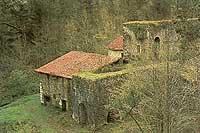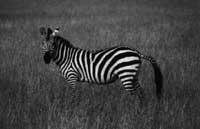Five hundred bugs!
2005/02/01 Kortabitarte Egiguren, Irati - Elhuyar Zientzia Iturria: Elhuyar aldizkaria
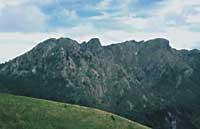
The natural park of Aiako Harria is located at the eastern end of Gipuzkoa. In the paleozoic massif in it are the oldest materials of Euskal Herria. The metamorfization of surface paleozoic materials by some igneous rocks and erosion has made that today we can see the spectacular mass of granite that forms Aiako Harria.
This curious formation organized in the lists of its different materials constitutes one of the greatest geological riches of the Basque Country.
Aiako Harria is formed by a series of narrow valleys shaped by the steep slope, ravines and waterfalls. Although part of the park is covered by conifers, excellent representatives of the native forest, such as the robledal-hayedo of Añarbe, the robledal-marojal of Endara and the hayedo of Oianleku are also preserved. In addition to these forests, in the units of vegetation that stand out most for their biological richness and singularity, the small sphagnales, the siliceous rocks and the communities associated with the streams of the protected margins stand out.
The fauna, in fact, is mainly Eurosiberian. The park has 147 species of vertebrates, among which are forest beasts (such as deer and boar) or aquatic (such as salmon). And as if it were not enough, thousands and thousands of invertebrates.
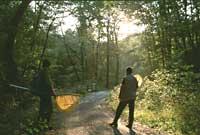
The old mines dress the park so well or better than the natural formations. The residues of this type of industrial farms dispersed throughout Aiako Harria model a very particular landscape, formed by interesting heritage. The cultural heritage that has survived the Prehistory can also be seen in a dispersed way, in particular dolmens, tumuli and cromlechs.
And why Aiako Harria and not the area of Aralar, for example? This type of research can be carried out in Aiako Harria, Gorbeia, Aralar, everywhere and with similar results in both cases. In this case, the main reason for choosing Aiako Harria has been the closeness, according to Gipuzkoan entomologists.
Step by step research
The study focuses on the constant search for insects on the mountain, especially between spring and autumn, since in winter the activity of insects slows down. The research began in 2000 and has lasted five years.
Besides going to the mountain, insects must be captured, and for this purpose three methods have been used: direct sampling, traps with ultraviolet light and traps with hook.
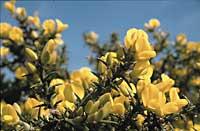
The correct sampling consists of making different routes during the day. And with the help of the network of insects, insects are collected. It is the most common methodology. It has been used especially in the case of lepidoptera of the day. The trap of ultraviolet light, as its name indicates, consists of the installation of ultraviolet light in different points of the night darkness, which attracts many insects, such as nocturnal lepidoptera and some coleoptera. In the trap with hook are placed underground containers with liquids of great smell, like the mixture of vinegar and beer. In addition to all this, they have also searched for insects within the cave.
Once the mountain activity is finished, all the material is brought home and prepared properly. And it is that each insect, or more specifically each order, needs its own treatment. The main difference is that some are kept on land and others in alcohol. For example, butterflies, beetles and bedbugs are treated dry; butterflies are applied with extended wings and many beetles and wrinkles with extended legs, on a cardboard. However, smaller insects are stored in alcohols.
All units must be properly labeled. The insect is of no use if it has no label (place, height, date...), that is, insects in the entomological collection need a label to serve.
When all material is ready, these insects are identified and information is sought about each of them, in books or with the help of experts, and the report is completed.
And what have you seen?

In total 500 species have been collected, 100 per year. This is the objective that was raised since the beginning of this project. And get it! Approximately a dozen of these species are new in the Iberian peninsula. Among them is the Ceuthosphodrus navaricus vasconicus, an endemic species of a cave located in Landarbaso (Errenteria).
For many groups, families and orders the first data have been given for the Basque Country and, of course, the degree of knowledge of the diversity of the natural park of Aiako Harria has increased considerably.
The project has provided abundant information on insects. In fact, although the data on the orders of lepidopter and coleopter were well known previously, the Gipuzkoan Association of Entomology has tried to collect all orders. For this purpose they have had to make approximately 500 exits to the mountain, since in Euskal Herria nothing has been done so far. They have paid special attention to their status in terms of distribution and conservation of the species present in the park. And, besides all this, they have managed to create a kind of network between entomologists around Aiako Harria, which no one doubts is an important step.
In short, you have to know the environment well. Gradually discover the entire area of the park with maps and thus study most of the habitats. The research project carried out by the Association of Entomology of Gipuzkoa will be presented under the title Entomofauna of the Natural Park of Aiako Harria, with the collaboration of the Diputación Foral de Gipuzkoa and the City Councils of Donostia-San Sebastián, Errenteria, Hernani, Irun and Oiartzartia.

Gai honi buruzko eduki gehiago
Elhuyarrek garatutako teknologia




